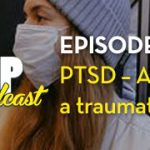PTSD – Anxiety following a traumatic event
Over the last few weeks we have been diverted from our planned series on anxiety to deal with various Covid19 issues that have arisen as the lockdown has, in different ways, affected us all. This weeks podcast completes our anxiety series and topically examines the disturbed and unresolved feelings that are the results of the events that many will have witnessed, especially our frontline workers. The effects of Covid19, that is not yet over, will have an emotional ripple effect that may last for several years. The symptoms of unresolved trauma are multiple but commonly include some flashbacks and problems with concentration, difficult emotional regulation, disturbed sleep and eating patterns and disrupted relationships. The question is what is trauma and what is it that we can do about it?
Trauma, is a Greek word meaning “wound”. Originally this was related to a physical injury. With the development of psychology and our understanding of the inner person we now say that a wound can be considered to be physical, mental, emotional, financial and so on. The concept of trauma comes from the idea that the wound, or event that is being experienced, is greater than the resources that we have to deal with it. In that sense we have been overwhelmed. However, there is a difference between experiencing trauma and being traumatised.
Traumatised, or traumatisation is when the overwhelming experience/trauma creates an amount of stress that is so great that it exceeds our ability to deal with the emotions aroused. This is clearly an emotional issue. Trauma or traumatic disorders are always emotional even if they come from physical damage.
Post trauma is the emotional fall out that stays with us after the experience has ended. This may be short term. It is our recovery time in which we process our emotions, this may take hours, days or weeks. In most cases the emotional effects of a trauma will be normalised within four weeks and sometimes extends to eight or ten weeks. The important thing is that is does subside as the emotional arousal is desensitised.
Repressed trauma can happen when an event is too difficult for us to deal with in the present and we hide it in the recesses of the mind. When this happens we may have no direct memory of the event that caused the trauma though it may still effect who we are, how we experience the world and, our behaviour. It is assumed that the mind repression developed to protect us from that which was too difficult to contemplate. In repression the victim will often fall sleep after the incident. In the the post incident sleeping process the R.E.M. (rapid eye movement) part of the sleep cycle, similar to dreaming, allows the memory to be coded and hidden or repressed in the back of our mind.
Recovered memory may be delayed by weeks, months, years, or even decades. Though when it does emerge the original repressed emotions are released as though the event has only just taken place. Therapeutically this release of emotion and memory is termed an ‘abreaction’ and involves the re-experiencing of the trauma physically, emotionally and mentally. This may occur many years after the original incident.
Emotional responses Although in repression the cognitive memory is lost to the consciousness mind it does have a constant effect on everyday life and experience and may appear as irrational fears, anxiety, depression, phobia etc. This is described and ‘something within us but outside of our control’. Perhaps you feel a sense of panic when you see the colour green. This may seem irrational because there is no logical reason for, or understanding why, this might be happening. Yet, the emotions related to the repressed memory remain active.
Post Traumatic Stress Disorder (PTSD) is when the emotional responses are not repressed but are also not processed. When the effects of the incident remain active after six to weeks it is given the PTSD diagnosis. As acknowledged above trauma may take eight to ten weeks to process. This means that definitions and diagnosis of PTSD can be difficult in the first instance. When we are looking at symptoms continuing after months or years we are definitely talking about PTSD.
PTSD Symptoms will vary but will include finding it difficult to forget the incident or event that happened. There may be flashbacks, daymares or nightmares about the incident. Unstable and irrational emotional responses such as anger, tears, anxiety, depression, phobias, disturbed sleep/eating patterns, and so on.
Rumination is the symptom builder. We know psychologically that, ‘what we think about we bring about’ and that ‘thoughts become things’. When we continually go over the traumatic incident we are unable to let it go. The more we ruminate on them the more it becomes intensely embedded in our unconscious and conscious mind because we as keep thinking about, and we are reinforcing it in our mind/brain.
The MindBrain is where the software of the psychological mind and the hardware of the brain interface. The main aspect of the brain that effects our emotional self is the limbic system in the centre of the brain. Within the limbic system is a little organ call the amygdala. In this organ are templates of cells that relate to out emotional responses.
Let say that when I am young I watch my mother reacting phobic-ally to spiders, I then build a template of cells in my amygdala so that when I see a spider the template of cells release chemistry and so I also react to the spiders as a phobia. Over time my spider template will become hotter and more embedded the more I visit it. ‘What you feed grows and what you starve dies’. With rumination the issues will only ever get bigger.
All emotional responses are like this, even the positive ones. So, that if I see the object of my love the love template of cells in my Amygdala become hot and release the chemistry that make me feel loving. If on the other hand I see the object of my hatred, that template will then become hot and release the chemistry anger, hatred etc.
It normally takes about five repetitions of an emotional experience to set up a template in the amygdala which is then built and embedded as we revisit it. If an event is so intense then the template is punched in traumatically and the template is created immediately. Once a traumatic template has been established it will remain hot and active and become ever more embedded over time unless, or until, it is treated and desensitised.
Treatment for trauma is a variable feast and will depend on where you live and the therapy that is available to you or which is fashionable at the time. Cognitive therapies such as CBT (cognitive behavioural therapy) are not that good at dealing with trauma in the longterm. They do have a short term effectiveness by putting in place cognitive tools that often repress the emotion. This has the immediate effect of creating a feeling of relief and assumed cure. However, when this happens the emotions are not processed but held in check leaving them to often reappear at a later date.
EMDR or Eye movement desensitisation and reprocessing is a therapy that mimics the rapid eye movements that happen during the dream cycle in the sleep pattern. As the emotional trauma is often encoded into the MindBrain using the same part of the system EMDR is surprisingly effective in the majority of cases.
Rewinding is by far in my opinion the best option as it uses the very same process to desensitise a template in the amygdala that was used to put it there in the first place, this is visualisation. When we revisit a trauma it is through the senses of sight, smell, tastes and touch, none of which are cognitive. During rewind therapy the emotional memories are address directly and desensitised.
Mindful meditation is becoming main stream psychology. Mindfulness is the best prevention for all forms of stress and provides the resources needed at the point of trauma. The process of mindfulness is relaxation, contemplation, concentration and meditation a process that is in itself therapeutic. Consistent meditators become their own therapists and counsellors and are able to overcome many things that may overwhelm others. When used with PTSD this needs to be a guided process with an experienced therapist. In the first instance the process of stilling the mind can allow repression’s, flashback and lost memories to appear from the recesses of the mind. When the subject is not prepared and supported though this stage it can simply reactivate the events and the emotional responses and recreate the trauma. When use well Mindfulness allows the subject to revisit those events that were overwhelming and deal with them and desensitise them.
Medication has to be the last on my list. I am not against medication on this basis, if I have a headache I will do all that I can to get rid of it, as a last resort I will take an aspirin. There are medications that can help with anxiety, depression, panic, high blood pressure and so on. There are also natural alternatives that maybe gentler on the system both psychologically and physiologically. If you do suffer trauma never suffer alone psychotherapy is a good and powerful thing.
The positive use of medication is when it runs alongside psychotherapy. When medication is used as a prop that can hold us up emotionally while we complete the desensitisation it has done its job and we can let the medication go. Many people are given the medication after a traumatic event but do not get the psychotherapy. This usually ends up with people becoming long term users and taking medication for many years when it should really have only been used for a few months.
Covid19 and PTSD
In the aftermath of this pandemic there will be many people who carry post trauma from their experiences. The survivor who wakes in intensive care to find themselves anchored to a bed with tubes and wires attended by people dressed in PPE, will develop some level of trauma. The frontline workers and triple nine workers that have experienced multiple deaths will have a lot of emotional and visual material to process and may become easily overwhelmed. Anyone who has lost people around them may also experience post trauma. However, everyone who listens to the news, goes to the shops, has to wear masks, is unable to associate or socialise or live their normal life in the normal way can become traumatised. The longer this goes on the more PTSD issue and cases will develop.
It is so important that we stay actively involved if only through social media, that we keep our bodies moving and do anything that we can to make ourselves and those around us happy.
Take care, stay safe, wash your hands, stay home, and do what you can to be happy
Sean x



Trackbacks & Pingbacks
[…] Sean has written a blog post to accompany this episode – read it here […]
Leave a Reply
Want to join the discussion?Feel free to contribute!